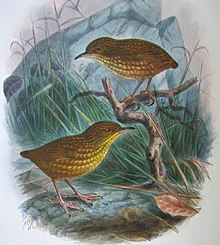Lyall's wren
It was described as a distinct genus, Traversia, in honour of naturalist and curio dealer Henry H. Travers, who procured many specimens from Lyall.The lighthouse keeper described the 'rock wren', as he called it, as almost nocturnal, "running around the rocks like a mouse and so quick in its movements that he could not get near enough to hit it with a stick or stone".[7] Its disappearance from the mainland was probably due to predation by the Polynesian rat or kiore (Rattus exulans), which had been introduced by the Māori.Much of what is commonly assumed to be established knowledge about this species' extinction is either wrong or has been misinterpreted, starting with the account by Rothschild (1905) who claimed that a single cat had killed all of the birds.""And we certainly think that it would be as well if the Marine Department, in sending lighthouse keepers to isolated islands where interesting specimens of native birds are known or believed to exist, were to see that they are not allowed to take any cats with them, even if mouse-traps have to be furnished at the cost of the state.




John KeulemansConservation statusExtinctIUCN 3.1Scientific classificationEukaryotaAnimaliaChordataPasseriformesAcanthisittidaeRothschildBinomial namepasserinefamilyNew Zealand wrensStephens IslandCook Straitspecieslighthouseferal catsWalter RothschildWalter Bullerscientific nameHenry H. TraverspasserinesOligocenesongbirdsflightlessislandslong-billed wrenstout-legged wrenlong-legged buntingTenerifeCanary IslandsprehistoricMāorilaughing owlsPolynesian ratHamilton's frogJohn BlackettriflemansteamboatNZGSS HinemoaLondonJohn Gerrard KeulemanslithographSouth Island rockwrenErnst HartertBritish Ornithologists' ClubPhilip SclaterBulletin of the British Ornithologists' ClubalcoholvisceraChristchurchThe Pressjunior synonymWellington Philosophical SocietySouth Island piopioMarine DepartmentJames HectorHenry Baker TristramOtago MuseumExtinct Birdsnil nisi bonumHabitat destructionsubfossilNatural History MuseumAmerican Museum of Natural HistoryNew York CityAcademy of Natural SciencesPhiladelphiaHarvard Museum of Comparative ZoologyCambridge, MassachusettsCarnegie MuseumPittsburghCanterbury MuseumWorld Museum, National Museums LiverpoolMuseum of New Zealand Te Papa TongarewaWellingtonDunedinTe PapaSouth Pacificgame showYouTubeNew Zealand wrenCats in New ZealandIUCN Red List of Threatened SpeciesBibcodeBull. B. O. C.WikispeciesBirds of New ZealandBellbirdBlack-billed gullBrown creeperBrown tealBuff-banded railDabchickDouble-banded ploverNew Zealand falconFantailGrey warblerGrey-faced petrelSacred kingfisherLong-tailed cuckooKererūNew Zealand dotterelSouth Island robinNorth Island robinNew Zealand scaupParadise shelduckPūkekoNew Zealand rock wrenShining cuckooSilvereyeSouth Island oystercatcherSpotted shagTomtitVariable oystercatcherWhite-fronted ternWhiteheadWrybillGreat spotted kiwiLittle spotted kiwiNorth Island brown kiwiOkarito kiwiSouthern brown kiwi